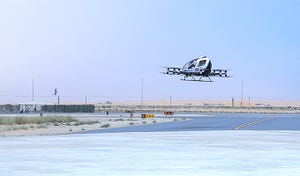Flying Cars Meet Quantum Computing
Quantum offers the capabilities of optimized flight paths and improved design
.png?width=850&auto=webp&quality=95&format=jpg&disable=upscale)
Flying cars and quantum computers have long been shorthand for “technologies of the future,” but they are both here and are now and on the verge of revolutionizing the world of transportation.
Piloted and non-piloted passenger electric aerial vehicles (EAVs) are taking off, with a surge of investments underway and the FAA having set 2028 as the year in which EAVs will be commercialized in a major way.
Quantum computing is experiencing similar growth, with the market predicted to be worth $170 billion by 2032 and many current real-life use cases already proving its value.
However, the commercialization of flying cars will introduce several challenges in determining the optimum flight path to save money and fuel while staying safe.
Like what you're reading? For more stories like this on emerging technologies, sign up for our free daily email newsletter to stay updated!
Flight path calculation is a critical risk-management use case that needs to consider factors including the time, speed and route of the journey while satisfying airspace constraints and minimizing risks related to weather, obstacles and other aircraft.
This risk-based, multifactor decision-making is an example of a real-world complex optimization problem ideally suited to certain types of quantum computing. Some organizations have already run trials on fleets of unmanned aerial vehicles, which face similar challenges.
Scaling Quantum Drone Routing for Flying Cars
Quantum Computing Inc. (QCI) launched a partnership with the Virginia Innovation Partnership Corporation (VIPC) last October to determine the best flight trajectories for UAVs using QCI’s Qatalyst software and Quantum Photonic Systems hardware.
Giving an update on the program, QCI chief technology officer Bill McGann said the lessons learned could easily scale to passenger aircraft.
“The VIPC heavy-lift drone project is probably the best example of a transportation routing optimization program we’ve done. It's multi-dimensional, with things moving in X, Y and Z planes,” McGann explained.
“When you’re doing routing for a flying car, you have the ordinary optimization problem challenges, but also imagine if it crashes you don’t want it to be in a heavily populated area. This extra degree of freedom of motion is good for collision avoidance, but it makes the complexity of the problem much greater.”
McGann said QCI discovered that when the constraints for an on-time delivery are added to the routing problem, it quickly becomes intractable for classical computers. The project demonstrated that it was feasible on QCI’s entropy quantum computer and that it could scale as the hardware becomes more capable.
“I think the VIPC problem would scale very well into passenger transportation, manned or unmanned, like your Air Uber or Lyft,” he said. “But there'd be additional constraints, like on-time delivery points, which makes the problem very challenging, plus a lot more safety constraints with people on board.
“We can imagine that when you put a person inside of a vehicle that's now being autonomously flown or driven you have other criteria caused by the interaction between the vehicle and the person. That would add constraints, which would multiply the complexity of the problem. Safety and payload would be the most significant constraints in adding complexity.”
Other Use Cases
QCI was not the first company to explore the potential of quantum solutions for flying cars. Japan-based Sumitomo Corporation, Tohoku University and unmanned traffic management solutions specialist OneSky Systems started investigating quantum solutions specifically for flying cars back in 2021.
The Quantum Sky Project demonstrated using quantum computing to develop a real-time three-dimensional traffic control system for the era when hundreds or even thousands of air mobility vehicles would be flying in the sky. The researchers claimed their simulation improved the number of flying vehicles that could fly simultaneously by about 70%.
Beyond efficient routing and safe flying, quantum computing could also help the design of flying cars. Automobile and aircraft manufacturers are using quantum algorithms to develop novel materials and chassis shapes optimized for efficient aerodynamics and impact resistance. And several quantum research projects are revolutionizing battery design by studying the very quantum physics that underlies the technology.
From the design, development and powering of passenger EAVs to getting to the office on time and safely, quantum computing could deliver a future with practical flying cars that is closer than may be imagined.
This article first appeared in IoT World Today's sister publication Enter Quantum.
Read more about:
Flying CarsAbout the Author(s)
You May Also Like
.png?width=100&auto=webp&quality=80&disable=upscale)
.png?width=400&auto=webp&quality=80&disable=upscale)




.png?width=300&auto=webp&quality=80&disable=upscale)

